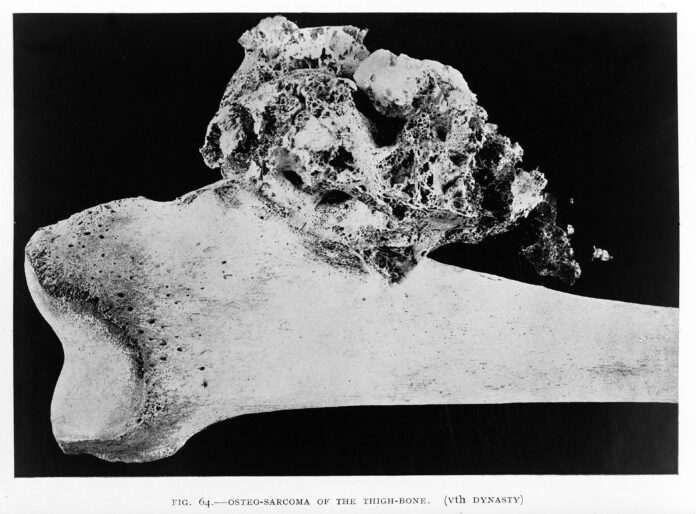
Understanding Osteosarcoma: The Most Common Form of Bone Cancer
Osteosarcoma, also known as osteogenic sarcoma, is the most common type of bone cancer. It primarily affects the long bones, such as the arms and legs, although it can also develop in the pelvis and other bones. Osteosarcoma is a rare disease, with only around 400 cases diagnosed in the United States each year, but it is a serious and potentially life-threatening condition if not diagnosed and treated early.
In this article, we will take a closer look at osteosarcoma, including its causes, symptoms, diagnosis, and treatment options. Understanding this disease is crucial for early detection and effective management, which can significantly improve the outcomes for those affected by osteosarcoma.
Causes and risk factors
The exact cause of osteosarcoma is still not fully understood. However, several risk factors have been identified that may increase the likelihood of developing this type of bone cancer. These risk factors include:
– Age: Osteosarcoma is most commonly diagnosed in adolescents and young adults, with the peak incidence occurring between the ages of 10 and 30.
– Genetic disorders: Certain genetic conditions, such as Li-Fraumeni syndrome, hereditary retinoblastoma, and hereditary multiple exostoses, are associated with an increased risk of developing osteosarcoma.
– Radiation exposure: Previous exposure to high doses of radiation, such as during cancer treatment, may also increase the risk of developing osteosarcoma.
– Paget’s disease: This bone disorder, characterized by abnormal bone growth, has been linked to an increased risk of osteosarcoma.
– Other bone conditions: Certain benign bone tumors and bone abnormalities, such as fibrous dysplasia, may also increase the risk of developing osteosarcoma.
Symptoms
The symptoms of osteosarcoma can vary depending on the location and size of the tumor. Common signs and symptoms may include:
– Pain: Persistent, localized bone pain that may worsen at night or with physical activity is a common symptom of osteosarcoma.
– Swelling: Swelling or a palpable lump may be present in the affected area, especially if the tumor is located near the surface of the bone.
– Limited mobility: Osteosarcoma can cause stiffness and limited range of motion in the affected joint.
– Fractures: The weakened bone affected by osteosarcoma is more prone to fractures, especially with minor trauma or stress.
– Other symptoms: In some cases, osteosarcoma may cause fever, weight loss, and fatigue.
It is important to note that these symptoms can also be caused by other, more common conditions. However, if you or a loved one experience any of these symptoms, especially if they persist or worsen over time, it is important to seek medical attention for a thorough evaluation.
Diagnosis
Diagnosing osteosarcoma often involves a combination of imaging tests, such as X-rays, CT scans, MRI, and bone scans, as well as a tissue biopsy to confirm the presence of cancer cells. Additionally, blood tests may be conducted to assess levels of certain proteins and enzymes associated with bone metabolism, as well as to rule out other potential causes of the symptoms.
Once osteosarcoma is diagnosed, further tests, such as a chest CT or PET scan, may be performed to determine the extent of the disease and whether it has spread to other parts of the body, a process known as staging. Staging is crucial for determining the most appropriate treatment approach and predicting the prognosis for the patient.
Treatment
Treatment for osteosarcoma typically involves a combination of surgery, chemotherapy, and in some cases, radiation therapy. The specific treatment plan for each patient will depend on factors such as the size and location of the tumor, the stage of the disease, the patient’s overall health, and their age.
Surgery is usually the primary treatment for osteosarcoma and aims to remove the tumor while preserving as much of the affected bone as possible. In some cases, however, amputation of the affected limb may be necessary to achieve complete tumor removal. After surgery, reconstructive procedures may be performed to restore function and appearance.
Chemotherapy is often used before and/or after surgery to help shrink the tumor, kill any remaining cancer cells, and reduce the risk of recurrence. In some cases, radiation therapy may also be used to target the tumor or to alleviate symptoms in cases of metastatic disease.
Prognosis
The prognosis for osteosarcoma can vary widely depending on factors such as the size and stage of the tumor, the patient’s age and overall health, and the response to treatment. Overall, the prognosis for osteosarcoma has improved in recent years, with current five-year survival rates ranging from 60% to 70% for localized disease and 20% to 30% for metastatic disease.
Research and ongoing clinical trials are focused on improving the outcomes for patients with osteosarcoma, including the development of new treatment approaches, targeted therapies, and immunotherapies. Early diagnosis and prompt, multidisciplinary treatment are crucial for achieving the best possible outcomes for those affected by this disease.
Understanding osteosarcoma can help patients and their families better navigate the challenges of diagnosis and treatment, and it can also contribute to raising awareness and support for research efforts focused on improving the prognosis for this rare but serious form of bone cancer. If you or someone you know is experiencing symptoms that may be related to osteosarcoma, it is important to seek medical attention and explore all available treatment options. With early detection and comprehensive care, a positive outcome is possible for many patients affected by osteosarcoma.












